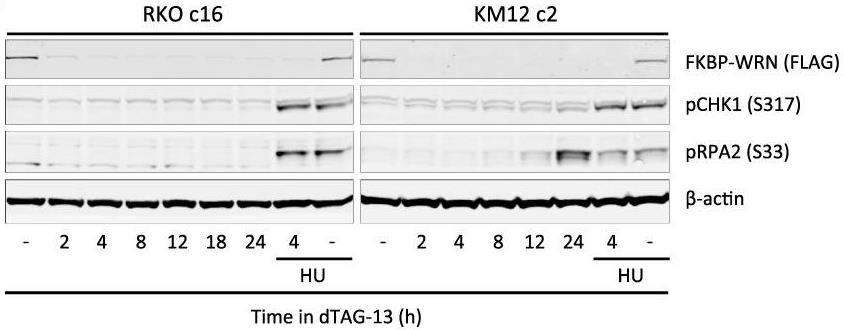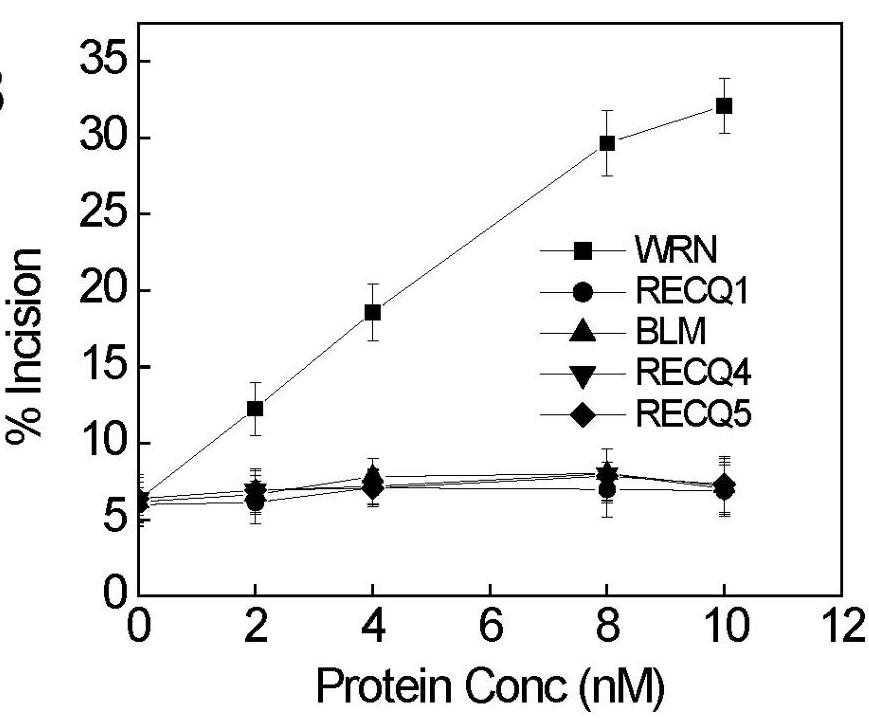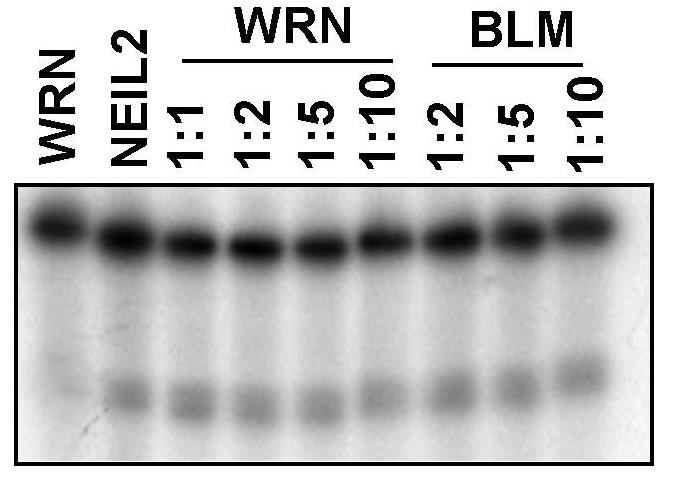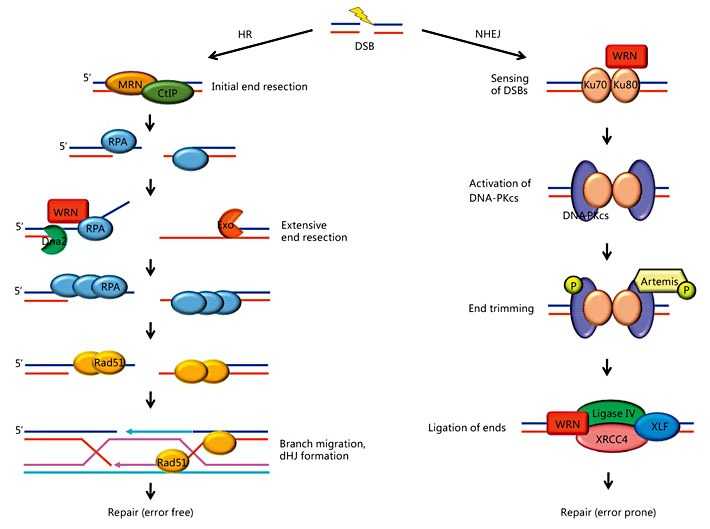Recombinant Human WRN
| Cat.No. : | WRN-30699TH |
| Product Overview : | Recombinant fragment of Human Werners syndrome helicase WRN with a proprietary tag: predicted molecular weight 37.84 kDa. |
- Specification
- Gene Information
- Related Products
- Case Study
- Application
- Download
| Species : | Human |
| Source : | Wheat Germ |
| Tag : | Non |
| Protein Length : | 111 amino acids |
| Description : | This gene encodes a member of the RecQ subfamily and the DEAH (Asp-Glu-Ala-His) subfamily of DNA and RNA helicases. DNA helicases are involved in many aspects of DNA metabolism, including transcription, replication, recombination, and repair. This protein contains a nuclear localization signal in the C-terminus and shows a predominant nucleolar localization. It possesses an intrinsic 3 to 5 DNA helicase activity, and is also a 3 to 5 exonuclease. Based on interactions between this protein and Ku70/80 heterodimer in DNA end processing, this protein may be involved in the repair of double strand DNA breaks. Defects in this gene are the cause of Werner syndrome, an autosomal recessive disorder characterized by premature aging. |
| Molecular Weight : | 37.840kDa inclusive of tags |
| Biological activity : | useful for Antibody Production and Protein Array |
| Form : | Liquid |
| Purity : | Proprietary Purification |
| Storage buffer : | pH: 8.00Constituents:0.79% Tris HCl, 0.31% GlutathioneNote: Glutathione is reduced |
| Storage : | Shipped on dry ice. Upon delivery aliquot and store at -80oC. Avoid freeze / thaw cycles. |
| Sequences of amino acids : | NPPVNSDMSKISLIRMLVPENIDTYLIHMAIEILKHGPDSGLQPSCDVNKRRCFPGSEEICSSSKRSKEEVGINTETSSAERKRRLPVWFAKGSDTSKKLMDKTKRGGLFS |
| Sequence Similarities : | Belongs to the helicase family. RecQ subfamily.Contains 1 3-5 exonuclease domain.Contains 1 helicase ATP-binding domain.Contains 1 helicase C-terminal domain.Contains 1 HRDC domain. |
| Gene Name | WRN Werner syndrome, RecQ helicase-like [ Homo sapiens ] |
| Official Symbol | WRN |
| Synonyms | WRN; Werner syndrome, RecQ helicase-like; Werner syndrome; Werner syndrome ATP-dependent helicase; RECQ3; RECQL2; |
| Gene ID | 7486 |
| mRNA Refseq | NM_000553 |
| Protein Refseq | NP_000544 |
| MIM | 604611 |
| Uniprot ID | Q14191 |
| Chromosome Location | 8p12 |
| Pathway | Regulation of Telomerase, organism-specific biosystem; |
| Function | 3-5 DNA helicase activity; 3-5 exonuclease activity; ATP binding; ATP-dependent 3-5 DNA helicase activity; ATP-dependent DNA helicase activity; |
| ◆ Recombinant Proteins | ||
| WRN-13H | Recombinant Human WRN Protein, non-tagged, Asn500-Gln1229 | +Inquiry |
| WRN-1390H | Recombinant Human WRN Protein(517-1093aa), His-tagged | +Inquiry |
| WRN-18584M | Recombinant Mouse WRN Protein | +Inquiry |
| WRN-1388H | Recombinant Human WRN protein, His&Myc-tagged | +Inquiry |
| WRN-30699TH | Recombinant Human WRN | +Inquiry |
Case 1: Zong D, et al. Genes Dev. 2023
MSI-H cancers rely on the WRN helicase, and while their eventual demise without WRN is known, the initial response to its loss is not fully understood, which is crucial for developing WRN-targeting therapies. Researchers developed a system to rapidly degrade endogenous WRN, allowing us to study the immediate effects. They discovered that acute WRN loss causes DNA damage that accumulates across replication cycles without engaging checkpoint mechanisms, leading to aberrant mitoses and cell death. Importantly, they found no adaptive mechanisms in MSI-H cancers facing near-complete WRN loss, but combining partial WRN degradation with low-dose ATR inhibition significantly enhanced efficacy.

Fig1. Targeting strategy to achieve knock-in of FKBP-WRN at the endogenous human WRN locus.

Fig2. Immunoblotting of dTAG-treated RKO FKBP-WRN cells.
Case 2: Popuri V, et al. DNA Repair (Amst). 2010
NEIL1, similar to the bacterial enzyme endonuclease VIII, is a DNA repair enzyme that fixes specific oxidative DNA damages. Researchers has found that WRN, a human RecQ helicase, enhances NEIL1's activity on these lesions. This study aimed to investigate whether all five human RecQ helicases interact with NEIL1 and the DNA substrate requirements. They discovered that only WRN activates NEIL1, and this requires a double-stranded DNA substrate.

Fig1. Stimulation of NEIL1 incision activity on duplex substrate with FapyA lesions specifically by WRN.

Fig2. WRN can't stimulate NEIL2.
Werner Syndrome Helicase (WRN) is a multifunctional DNA helicase belonging to the RecQ family of helicases. It plays an important role in DNA replication, repair, recombination and telomere maintenance. WRN proteins have DNA helicase activity in the 3' to 5' direction and exonuclease activity in the 3' to 5' direction and are involved in a variety of DNA metabolic pathways. WRN is essential for maintaining genomic stability and preventing progeria and certain cancers. WRN also plays a role in the cell's response to DNA damage, affecting cell cycle regulation and DNA repair signaling pathways.
In medical research, the WRN protein has received attention for its role in DNA repair, and mutations in the WRN gene have been linked to Werner syndrome, a premature aging disorder. Recombinant forms of the WRN protein are used in biomedical research to study mechanisms of DNA repair, cellular aging, and cancer development. WRN is also a potential therapeutic target for microsatellite unstable cancers, and clinical trials of WRN inhibitors are currently underway to treat solid tumors. In addition, inhibitors of WRN may become a new strategy for the treatment of certain types of cancer, for example, the conditional degradation of WRN through PROTAC technology provides a new way to selectively kill cancer cells with microsatellite instability.

Fig1. Potential functions of WRN in DSB repair. (Jin-Sun Ryu, 2016)
Not For Human Consumption!
Inquiry
- Reviews
- Q&As
Ask a Question for All WRN Products
Required fields are marked with *
My Review for All WRN Products
Required fields are marked with *
Inquiry Basket


